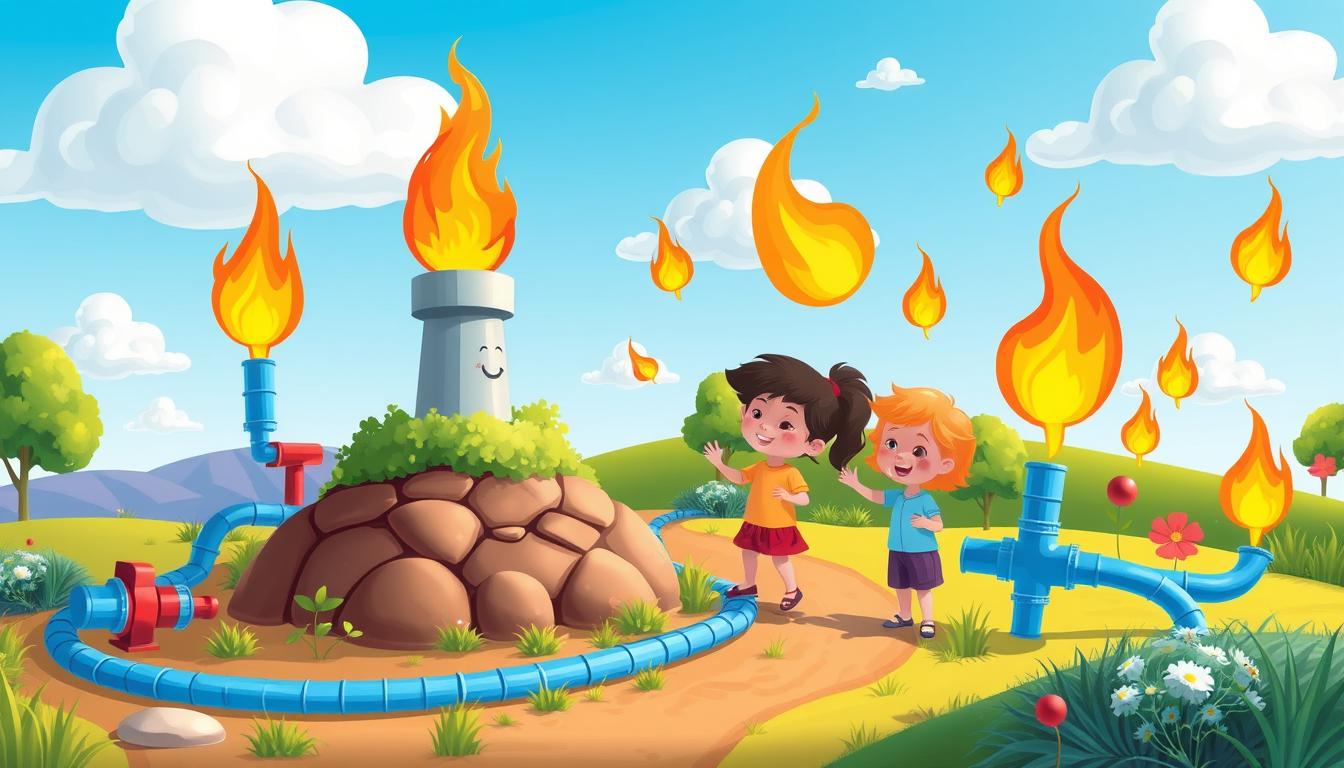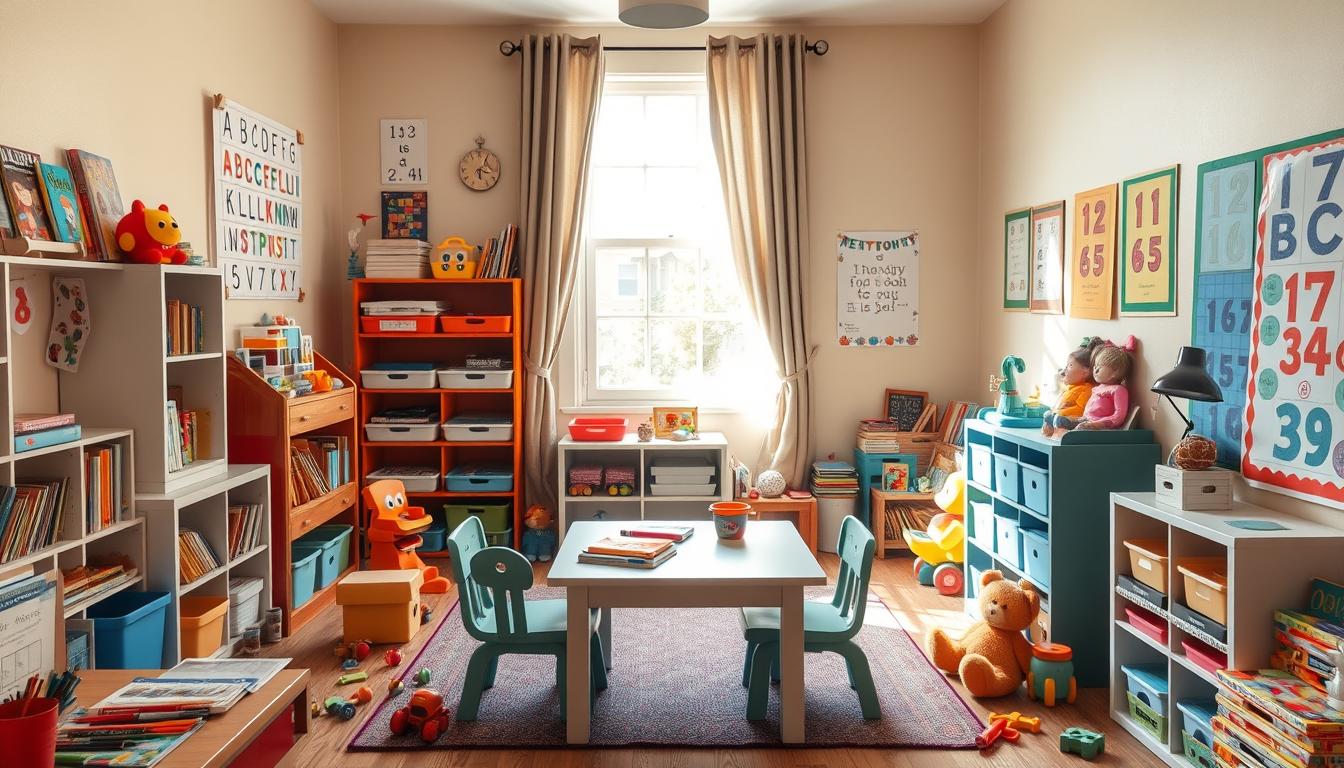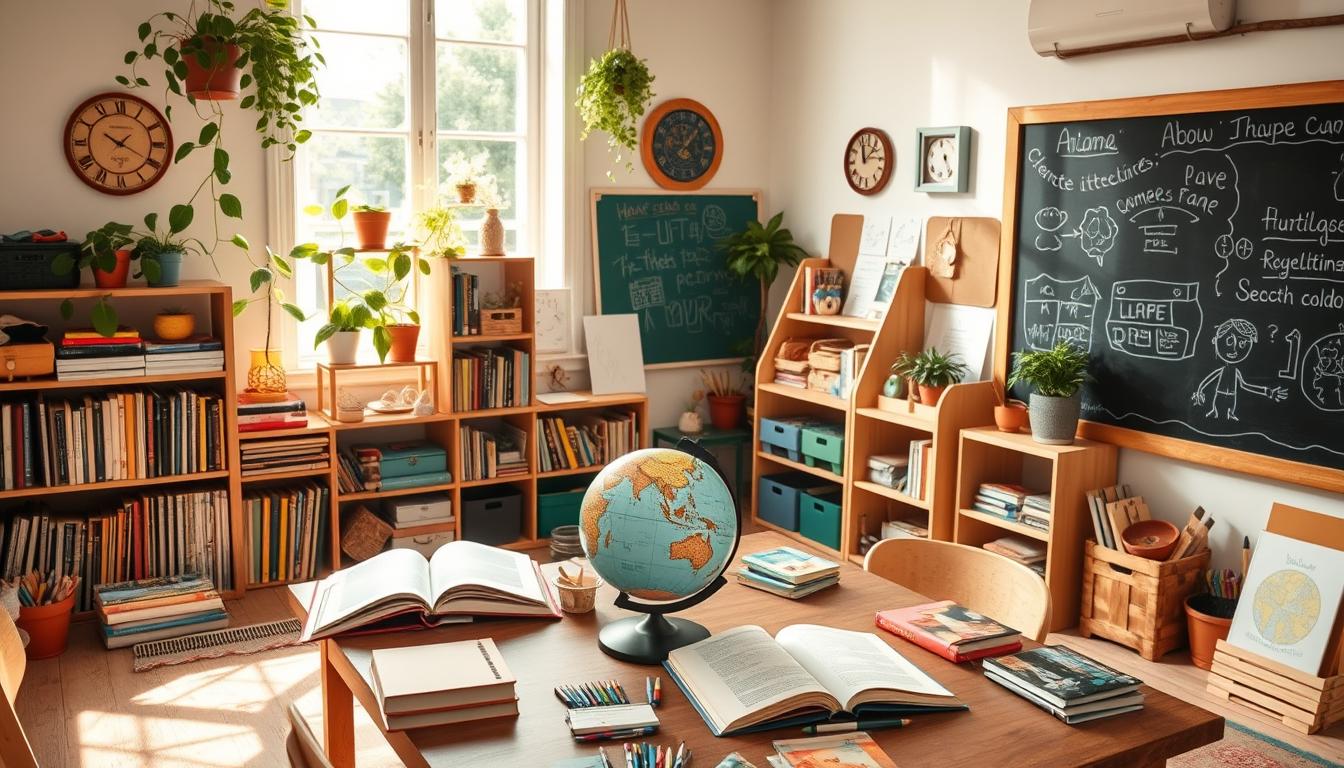Exploring natural gas can be a thrilling adventure for kids. These articles aim to spark their curiosity about this energy source. They cover everything from where it comes from to how it’s used, making learning fun and engaging.
Natural Gas Articles For Kids To Help With Education
These articles use stories and interactive content to teach about natural gas. They show how it affects our daily lives, from powering homes to fueling cars. By learning about it, kids can become more aware and responsible with our energy.
Let’s start this educational journey together. We’ll uncover the amazing stories and facts about natural gas. It’s a chance to open up a world of possibilities for the curious young minds around us.
What Is Natural Gas and Where Does It Come From?
Natural gas is a fossil fuel that has been important for centuries. It’s a colorless, odorless gas mostly made of methane. It powers our homes, transport, and industries. But, do you know how it’s made and where it’s found?
The Formation of Natural Gas Through Millions of Years
Natural gas forms over millions of years through a complex process. It comes from ancient plants and animals buried deep in the Earth. This process, called thermogenic formation, turns them into the natural gas we use.
Common Places Where Natural Gas Is Found
- Sedimentary rock formations, like shale and sandstone, are common places for natural gas.
- It’s also found in underground reservoirs, trapped by rock layers.
- Offshore, natural gas lies beneath the seafloor, in both shallow and deep waters.
Different Types of Natural Gas Sources
There are many types of natural gas sources, each with its own features and ways to extract it:
- Conventional Natural Gas: This is the most common type, found in traditional underground reservoirs.
- Shale Gas: Trapped in shale rock, it needs advanced methods like hydraulic fracturing.
- Coalbed Methane: Found in coal seams, it’s extracted with special drilling.
- Tight Gas: In low-permeability rock, it also needs advanced techniques.
Knowing how natural gas is formed and where it’s found is key for young learners. It helps them understand natural gas facts for young learners and kid-friendly natural gas information.
Fun Facts About Natural Gas That Kids Will Love
Natural gas is full of cool facts that kids will find fascinating. It has a long history and many uses today. Let’s explore some fun facts about natural gas that will make learning exciting.
- Did you know natural gas has been used for thousands of years? The ancient Greeks and Chinese used it for heating and lighting.
- Natural gas is called the “cleanest” fossil fuel. It burns well and makes fewer emissions than coal or oil.
- Natural gas smells like nothing in its natural form. Companies add a smell to it so leaks can be found easily.
- Natural gas is also very flammable. But it’s lighter than air, so leaks just rise and disappear.
- Natural gas helps make many things we use every day. This includes plastics, fertilisers, and fabrics. It’s really useful!
These facts show how interesting natural gas can be. By learning about it, kids can understand its importance. They’ll see how it helps our world today.
“Natural gas is one of the most versatile and efficient energy sources we have, and understanding its history and impact is key to a brighter future.”
How Natural Gas Powers Our Everyday Lives
Natural gas is a key energy source in our daily lives. It powers our homes, fuels our transport, and supports industries. This clean-burning fuel is vital for modern society. Let’s see how natural gas enriches our lives.
Natural Gas in Our Homes
In our homes, natural gas is reliable and efficient. It heats our homes, cooks our meals, and runs appliances. It’s a popular choice for its convenience and cost savings.
Families enjoy warmth from natural gas heating in winter. It also lets cooks prepare delicious meals with precision.
Natural Gas in Transportation
Natural gas is also key in transport. It fuels cars, trucks, and buses through CNG and LNG. This reduces emissions and saves money for drivers and fleets.
As we focus on the environment, natural gas is seen as a cleaner option. It helps us move towards a greener future.
Industrial Uses of Natural Gas
Natural gas is crucial for industries too. It’s used to make petrochemicals, essential for many products. It fuels industrial processes like glass making and steel production.
Natural gas is vital for our daily lives. It keeps us warm, moves us, and drives industries. Understanding its role helps us value its importance in our world.
Safety First: Understanding Natural Gas for Young Learners
When it comes to natural gas classroom resources and kid-friendly natural gas information, safety is key. Natural gas is all around us, powering our daily lives. It’s vital that kids learn to handle it safely.
Children should know how to spot a gas leak. Natural gas is odourless, so a rotten-egg smell is added to help detect any leaks. If they smell this smell, they should tell a trusted adult right away. This could mean a big safety issue.
- Explain the importance of never using matches, lighters, or other open flames near natural gas appliances.
- Emphasise the need to keep natural gas equipment well-maintained and regularly inspected by qualified professionals.
- Encourage children to never attempt to fix or tamper with natural gas equipment themselves.
In a gas emergency, like a leak or fire, kids need to know what to do. Teach them to get out of the area fast. Tell them not to try to turn off the gas themselves. Instead, they should tell a grown-up or call emergency services.
“Educating children about natural gas safety is paramount. By instilling these essential lessons, we can empower them to be responsible and proactive in their interactions with this important energy source.”
By using these natural gas classroom resources and kid-friendly natural gas information in your teaching, you’re helping to raise a safe and informed next generation of natural gas users.
Natural Gas Articles For Kids To Help With Education
Exploring natural gas can be fun and educational for kids. We’ve picked out some great resources for them to learn about this important energy source.
Age-Appropriate Reading Materials
We have articles for kids of all ages. They cover everything from how natural gas is made to its uses. These natural gas articles for kids aim to make learning exciting and help them understand this vital energy.
Interactive Learning Resources
Interactive tools like quizzes and games make learning about natural gas fun. These natural gas resources for students get kids involved and help them remember important facts in a fun way.
Educational Videos and Animations
Videos and animations make natural gas science come alive. They help kids see and understand complex ideas. These educational tools offer a fun and engaging way to learn about natural gas.
| Resource Type | Example | Target Age Group |
|---|---|---|
| Articles | “The Incredible Journey of Natural Gas” | 8-12 years old |
| Interactive Tools | “Natural Gas Exploration Game” | 10-14 years old |
| Videos | “How Natural Gas is Formed” | 6-10 years old |
We want to inspire and educate kids about natural gas. By offering a wide range of natural gas articles for kids and natural gas resources for students, we hope to make a difference.
Environmental Impact of Natural Gas Made Simple
As natural gas grows in popularity, it’s key for kids to grasp its environmental effects. Compared to coal and oil, natural gas explained for children is cleaner and more efficient.
One big plus of natural gas facts for young learners is its lower carbon emissions. Burning natural gas releases less carbon dioxide than coal or oil. It also has fewer air pollutants like particulate matter and nitrogen oxides. These pollutants can harm air quality and health.
| Emission Type | Natural Gas | Coal | Oil |
|---|---|---|---|
| Carbon Dioxide (CO2) | 53.07 kg/GJ | 94.63 kg/GJ | 73.30 kg/GJ |
| Nitrogen Oxides (NOx) | 0.39 kg/GJ | 0.59 kg/GJ | 0.49 kg/GJ |
| Particulate Matter (PM) | 0.01 kg/GJ | 0.12 kg/GJ | 0.08 kg/GJ |
The environmental effect of natural gas explained for children can change based on how it’s extracted, moved, and stored. Using natural gas responsibly can lessen its environmental impact. This makes it a better energy choice for the future.
“Natural gas is a cleaner-burning fossil fuel that can play an important role in the transition to a more sustainable energy future.”
Learning about natural gas facts for young learners helps kids make smart choices. They can become leaders in sustainability in their communities.
Exciting Natural Gas Experiments for the Classroom
Spark the curiosity of young learners with fun natural gas experiments. These activities teach kids about natural gas science in a fun way. They also help them understand this important energy source.
Safe and Supervised Activities
Safety is key in natural gas experiments. Teachers or adults should always supervise. Make sure kids wear goggles and gloves. Also, keep the classroom well-ventilated and safe.
Learning Outcomes and Objectives
- Learn about natural gas, like its flammability and density.
- Find out how natural gas is made and where it comes from.
- See how natural gas is used in our daily lives, like heating homes.
- Think critically about natural gas’s environmental impact and how to use it wisely.
| Experiment | Learning Outcomes | Materials Needed |
|---|---|---|
| Balloon Inflation with Natural Gas | Learn about natural gas density compared to air. | Balloons, natural gas, and a safe ignition source. |
| Natural Gas Combustion Demonstration | See how natural gas burns and the need for safety. | Glass jar, natural gas, and a safe ignition source. |
| Natural Gas Conversion Calculations | Practice converting natural gas measurements and units. | Worksheets, calculators, and natural gas conversion charts. |
These experiments are just a few examples of natural gas science projects for kids and fun natural gas learning activities. Hands-on learning helps students understand and appreciate natural gas’s role in our lives.
Natural Gas Conservation Tips for Young Environmental Champions
As a young environmental champion, you can really make a difference. By using simple conservation habits, you can cut down your energy use. This not only helps you but also encourages others to do the same. Let’s look at some easy ways to become a natural gas conservation hero!
Turn It Off When Not in Use
One simple way to save natural gas is to turn off appliances when not needed. This includes your heating system, gas stove, or water heater. Make it a habit to check these are off when not in use. Also, teach your family to do the same.
Embrace Energy-Efficient Appliances
When it’s time to get new appliances, pick energy-efficient ones. Look for the ENERGY STAR label, which means they’re energy-smart. These appliances save you money and reduce your carbon footprint.
Insulate Your Home
Good insulation is key to using less natural gas. Make sure your home is well-insulated, especially in walls, attic, and around windows and doors. This keeps your home warm in winter, using less gas.
Maintain Your Heating System
Keeping your heating system in top shape is important. Regularly change air filters and get tune-ups. This makes your system more efficient, saving gas and money.
By following these easy tips, you can help the environment and become a natural gas champion. Every small action you take helps towards a greener future.
“Conserving natural gas is not only good for the environment, but it’s also good for your wallet. Every bit of natural gas you save makes a difference.”
The History of Natural Gas Discovery and Use
Natural gas has been around for centuries. Ancient civilizations first found and used it. Its story is one of innovation and change.
Ancient Uses of Natural Gas
In ancient China, people used natural gas to boil water and warm homes by the 6th century BC. The Greeks and Romans also used it. They lit fires and rituals with it.
Modern Natural Gas Development
The 19th century marked the start of the modern natural gas industry. The first commercial well was drilled in the US in 1821. This growth changed how we power our lives.
Now, natural gas is key in the global energy mix. It’s clean and efficient for many uses. From heating to powering industries, natural gas explained for children is essential in our daily lives.
“Natural gas has transformed the way we live, work, and power our world. Its versatility and efficiency have made it an indispensable resource in the modern era.”
The future of natural gas looks promising. The story of natural gas articles for kids to help with education is about innovation and sustainability. It’s about powering tomorrow’s world.
Career Paths in the Natural Gas Industry
The natural gas industry has many career paths for young professionals. It includes engineering, science, business, and customer service roles. This field is exciting for those who love energy, technology, and innovation.
Gas exploration and production is a key area. It involves finding and extracting natural gas. You need skills in geology, geophysics, and petroleum engineering. Jobs here include geologists, petroleum engineers, and field operators.
The industry also needs transportation and distribution to get gas to homes and businesses. This creates jobs in pipeline construction, management, and maintenance. There are also roles in logistics and supply chain management.
- Natural gas plant operator
- Natural gas pipeline technician
- Natural gas safety inspector
- Natural gas market analyst
For those interested in business, sales, marketing, and customer service roles are available. These jobs involve working with clients, understanding their needs, and offering solutions.
Every career path in the natural gas industry is exciting. It lets young people help create sustainable energy solutions. They can make a big difference in the world.
TO WATCH THE VIDEO CLICK HERE
“The natural gas industry is at the forefront of the transition towards a cleaner energy future, and it’s an incredibly rewarding field to be a part of.”
Choosing a career in the natural gas industry is a great way to use STEM skills. Students can make a big impact on the energy future.
Understanding Natural Gas Measurement and Units
Measuring natural gas is fascinating for kids. It involves learning about volume and energy content. By doing simple math and unit conversions, they can appreciate the natural gas industry’s precision.
Simple Math Activities with Natural Gas
Learning about natural gas can be fun. Kids can figure out how much gas fills a balloon or the energy in a certain amount. These activities teach important concepts and boost problem-solving skills.
Converting Units Made Easy
Teaching kids about units like cubic feet, litres, and joules is easy with interactive demos. By showing them how to convert units, educators help them understand measurements’ real-world uses.
FAQ
What is natural gas and where does it come from?
Natural gas is a fossil fuel made deep underground over millions of years. It comes from ancient plants and animals. It’s found in certain rocks and often extracted with oil and coal.
What are some fun facts about natural gas that kids will love?
Natural gas is the cleanest-burning fossil fuel. It’s colourless, odourless, and flammable. It powers many things we use daily, like stoves, heaters, and cars.
How does natural gas power our everyday lives?
Natural gas heats, cools, and powers our homes’ appliances. It also fuels some cars, buses, and trucks. In industries, it makes plastics, glass, and steel.
What’s the best way to learn about natural gas safety for young people?
Learning about natural gas safety is key. Kids should know how to spot a gas leak and what to do in emergencies. Classroom resources and interactive activities help teach this importance.
Where can I find natural gas articles and resources for kids?
There are many educational materials for kids about natural gas. Look for age-appropriate articles, interactive tools, and videos. Your library or school might have them, or search online.
How does natural gas impact the environment?
Natural gas is cleaner than other fossil fuels. It produces less harmful emissions when burned. Still, using it wisely and conserving it is crucial.
Can kids do natural gas experiments in the classroom?
Yes, safe natural gas experiments can be done in class. They teach about natural gas properties and use. Always follow safety rules and have an adult nearby.
How can kids help conserve natural gas?
Kids can help by turning off lights and appliances, taking shorter showers, and staying warm in winter. Being mindful of energy use is important.
What’s the history of natural gas discovery and use?
Natural gas has been used for thousands of years. Early civilizations used it for light and heat. Today, it’s a key energy source thanks to new technologies.
What kind of careers are available in the natural gas industry?
The natural gas industry offers many careers. You can work in engineering, geology, environmental science, or technology. Studying maths, science, and technology can lead to these opportunities.
How is natural gas measured and what units are used?
Natural gas is measured in cubic feet or litres. Learning about these units is fun. It helps kids practice maths and understand natural gas use.
TO EXPLORE MORE TOPICS CLICK HERE



